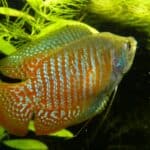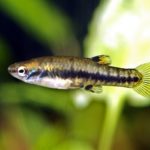The Pearl Gourami is a freshwater species that is native to Southeast Asia. Its scientific name is Trichopodus Leerii and it belongs to the Osphronemidae family.
This popular species of Gourami is not only beautiful to look at, but it is also hardy and easy to care for. As a labyrinth fish, it can breathe via its gills or by gulping air near the surface of the tank.

Although they are not overly difficult to care for, it does help to have some experience of owning these fish. Making yourself aware of the following factors will ensure that they live healthy lives.
Care Guide
Although Pearl Gourami are fairly easy to keep, they have certain care requirements that need to be met.
Tank Size
Pearl Gouramis require a tank with a 30 gallon capacity. This will provide them with plenty of space to swim and explore. Generally, it is recommended that you allocate between 5 and 6 gallons of water for each fish that you are intending to add to the tank.
The more fish that you add, the bigger the tank needs to be. Trying to add a small group of Pearl Gouramis to a tank with a lower capacity than 30 gallons will not provide each fish with the space that is needed.
Tank Mates
As a species with a peaceful temperament, Pearl Gouramis typically cope well in a community tank setup. Their tank mates can be small or large so long as they are not known to be aggressive. You should also avoid adding overactive fish.
This is because there is a risk of them stressing out the Pearl Gouramis. Moreover, do not opt for fish that are fin nippers as this can present an issue for the Pearl Gouramis. The following species are believed to be compatible with these fish. This includes neon tetras, dwarf cichlids, cherry barbs, danios, guppies, platies, cory catfish, kuhli loaches, and swordtails.
Same Species Tanks
Whilst Pearl Gouramis can be kept alone, they do better when kept in a school. It is worth noting that the males tend to show more signs of aggression towards other males members of the same species, whilst the females are a lot more tolerant.
As such, it is recommended that you keep a ratio of 1 male with 2 to 3 females. This will eliminate any risks of the males fighting with one another. When these fish are kept in groups, they are likely to live enriched and fulfilled lives.
When kept in a group, the colors of this beautiful species are going to be a lot more prominent, this making them fascinating to watch as they swim around the tank.
Water Parameters
The conditions of your tank should replicate the conditions of the environment that these fish are normally found in. As a tropical species, they should be kept in water that is between 77 and 82 degrees Fahrenheit.
In the wild they prefer soft, slightly acidic water, however, in captivity, they are a lot more adaptable and receptive. As such, they can tolerate a pH within the range of 6.5 and 8. In regards to water hardness, they prefer it to be between 5 and 25 dH.
The hardiness of this species means that they can withstand different water conditions to what they are naturally used to, hence why they are a good choice for community tanks.
What To Put In Their Tank
The natural environment of Pearl Gouramis is usually heavily vegetated so you will need to make sure that you add plenty of plants. They do not eat a lot of plants so you are not limited when it comes to deciding on the varieties that you add. You should make sure that your plants of choice have strong roots.
Position them around the back and sides of the tank. You can also add some floating plants as this is going to keep the tank a little more sheltered. This species is not overly fussy when it comes to a substrate, however, we would advise you to select one that is sandy and not too rough.
In the waters where Pearl Gouramis are naturally found there are a lot of rocks so it is a good idea to add a few to your aquarium. We also recommend that you add some driftwood and logs.
It is important to make sure that you do not overcrowd your tank by decorating it too heavily. This is because lots of plants and animals will consume too much space. This can inflict unnecessary stress upon the Gouramis.
You may also wish to add a filtration system to your tank. Should you decide to do so, you must make sure that it is not too powerful. This is because a powerful filtration system is going to produce a heavy flow of water and this species naturally prefers slow-flowing water.
Common Diseases
Although this species is pretty tough, just like other fish, it is not immune to disease. Fin rot is a disease that is particularly problematic for this species. Fin rot is a bacterial infection that causes the fins to become discolored before rotting. It can also occur as a result of fin nipping. If this condition is not treated it can spread to the entire fin.
This disease is also preventable, permitting that your fish are kept in the optimal environment. It is important to change the water regularly and conduct regular checks.
Food & Diet
These fish are an omnivorous species that are not particularly fussy about what they eat. You need to make sure that they are accessing all of the necessary nutrients in their diet. It is also worth noting that the diet of your fish can affect how well they develop.
In their natural environment, they normally eat algae, small insects, eggs, and larvae. When kept in captivity, they can be fed flake food, frozen food, and live food.
Should you decide to feed them dried food, you must make sure that it is of good quality from a reliable source. You will then need to supplement their diet with live foods. Not only does this provide them with a tasty treat, but it also encourages them to work for their food.
Lifespan
On average, a Pearl Gourami is expected to live for between 4 and 5 years. In some rare cases, they have lived for as long as 6 years. Of course, there is no guarantee as to how long your fish are going to live.
Just because they are a hardy species does not mean that they are going to reach their maximum lifespan unless they are provided with the proper care.
Appearance
As implied by their name, these fish have pearl-like markings on their bodies. Their appearance has made them a popular addition to many aquariums. They are unique, colorful, and have a black line running down their bodies.
The spots that cover their bodies make it easy to differentiate between these fish and other Gourami species.
Their fins are thin and large and their bodies are also thin. These unique features give them a delicate look.
Pearl Gourami Size
Pearl Gourami can measure up to 5 inches long. This measurement does not cover the size of their ventral fins as they are normally just as long as their bodies.
Behaviour & Temperament
These fish share many similar personality traits to other Gourami species. As they are a peaceful species they do not usually bother the other fish that they share a tank with. However, they can show signs of aggression during the spawning season, especially the males that are guarding the nests.
Breeding
Breeding Pearl Gouramis isn’t an overly challenging process. Breeding occurs via bubble nests. Simply put, the males will blow bubbles when they are ready to mate and these bubbles will sit on the top of the water. During spawning, you must make sure that all of the fish feel comfortable. Also, these fish will breed in couples.
The male will then put on a display for the female and spawning occurs, The female will then release the fertilized eggs into the bubble nest that the male previously created. Moreover, the males will then make it their responsibility to protect the nest from other fish in the tank.
Ideally, you should remove the female, otherwise, there is a risk of her being hurt by the male.
Gender Differences: Male vs Female
There are differences in the size and shape of male and female bodies. The males are larger but thinner than the females and are also more brightly colored. They also have red markings on their breast section.
The female fish has a fatter abdomen which makes it look plumper. Furthermore, there are also differences in the size of their dorsal fins. The males have a longer dorsal fin which is also more pointed than that of the female.
Pearl Gourami Fun Facts
- Pearl Gourami are known to vocalize. As such, you may hear your fish ‘talk’ or croak.








